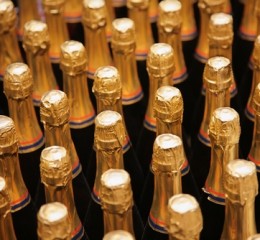


A few grams of sugar. Brut, demi-sec, sec? Were you aware that just a few grams of sugar differentiate these various champagnes? At the end of the champagne process (see Making Champagne) a few drops of liqueur de dosage (a mix of sugar and champagne) is added. The quantity of sugar is rigorously controlled and determines several appellations: doux more than 50g of sugar per litre of wine; demi-sec, between 33 - 50g; sec, between 17 – 35g; extra dry, between 12 - 20g; brut, less than 15g; and extra brut between 0 – 6g. Demi-sec is best adapted to desserts; however, Brut today represents 90% of the market. A Blanc de Blanc is a champagne which has come exclusively from Chardonnay grapes. A pink champagne can be created in two different ways. Either add some red champagne wine which will tinge the champagne or macerate the skin and some juice during the first fermentation (see Making Champagne) which will tinge the wort.
A Millésime is a champagne of rare quality which cannot be sold before the 4th year after being finally bottled (ie nearly 6 years after the grape from which it was made was harvested).
Back in the 19th century certain champagne houses invented red champagne, which came from mixing champagne, 25% non-sparkling red wine and a red liqueur. This champagne was finally banned in 1987. Champagne is universally known.
Of the 300 million bottles produced each year 60% are consumed in France. The United Kingdom is the leading importer of champagne. Indeed, Brut champagne was originally devised for that market since the British especially like dry wines.
Brut champagne is the type which is, by far, the most sold in France and throughout the world. It wasn't always so. In the 18th century, the demi sec was preferred. Barely sweet, it left all the wine's subtleties in the mouth. That's the way that the terroir and the grape can both be best discovered. It's particularly suitable as an aperitif, accompanying sea food (caviar, salmon, oysters) or desserts with dark chocolate.
Brut indicates that the champagne is less worked at than others. It's the quantity of liqueur de dosage (see Making champagne) which has been introduced just before the final bottling that makes the difference. Brut champagne must have less than 15g sugar/litre, as against 50g for Doux champagne.